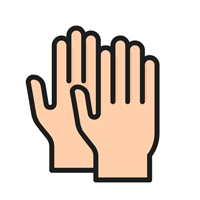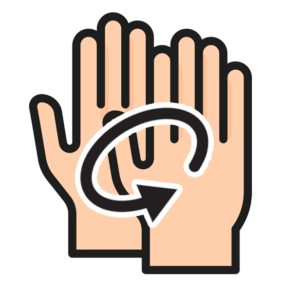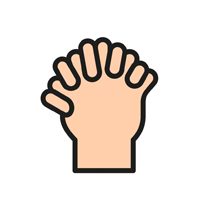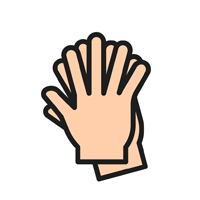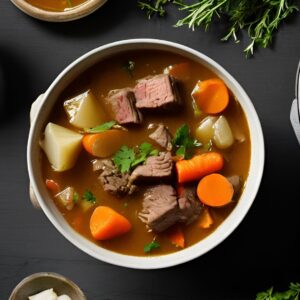Basic Seafood Preparation Techniques
Cleaning and gutting fish are essential skills for any chef to ensure the fish is safe to eat and ready for cooking. Here is a detailed guide on how to scale, gut, and fillet fish, along with tips for mastering these techniques.
Scaling Fish
Description: Scaling removes the fish’s scales, which are inedible and can interfere with cooking.
Tools Needed: Scaling tool, blunt knife, or the back of a chef’s knife.
Procedure:
- Preparation:
- Setup: Place the fish on a flat, stable surface like a non-slip cutting board. Ensure your workstation is clean and have a bowl of cold water nearby.
- Hold the Fish: Hold the fish firmly by the tail with one hand. You can use a cloth or paper towel for a better grip.
- Scaling:
- Direction: Using the scaling tool or the back of a knife, scrape the scales from the tail towards the head. This direction is opposite to the natural direction of the scales.
- Technique: Use firm, short strokes to lift the scales off. Be thorough, ensuring you remove scales from both sides and around the fins.
- Checking: Run your hand over the fish to feel for any remaining scales, and repeat the process if necessary.
- Rinsing:
- Rinse the Fish: Rinse the fish under cold running water to wash away any loose scales. Ensure no scales remain on the fish or the work surface.
Gutting Fish
Description: Gutting involves removing the internal organs of the fish to make it ready for cooking.
Tools Needed: Sharp filleting knife, kitchen shears, spoon.
Procedure:
- Preparation:
- Position the Fish: Place the scaled fish on a cutting board. Use a non-slip mat underneath the cutting board for stability.
- Initial Cut: Insert the tip of the knife into the fish’s belly near the anal opening.
- Cutting:
- Opening the Belly: Make a shallow cut from the anal opening up to the base of the fish’s jaw. Be careful not to cut too deeply to avoid puncturing the intestines, which can release unpleasant odors and contaminants.
- Removing Guts:
- Extraction: Use your fingers or a spoon to pull out the internal organs. Be thorough, ensuring you remove all the entrails and membranes.
- Bloodline Removal: For some fish, you may need to remove the dark red bloodline along the spine. This can be done by scraping it out with a spoon or the back of the knife.
- Cleaning:
- Rinse the Cavity: Rinse the cavity thoroughly under cold running water to remove any blood, bits of gut, and other residues.
- Final Check: Inspect the fish to ensure all organs and blood are removed.
Filleting Fish
Description: Filleting separates the fish’s flesh from its bones, yielding boneless pieces of fish.
Tools Needed: Sharp filleting knife, cutting board, fish tweezers.
Procedure:
- Preparation:
- Lay the Fish: Lay the fish on its side on the cutting board. Ensure the fish is stable by using a non-slip mat under the board.
- Cut Behind the Gills:
- Initial Incision: Make an incision behind the gills and pectoral fin down to the backbone. This cut should be just behind the head and angled towards the head.
- Cut Along the Backbone:
- Long Cut: Turn the knife so the blade is parallel to the backbone. Cut along the length of the fish, from the head to the tail, keeping the blade close to the backbone to maximize the amount of meat removed.
- Angle Control: Keep the knife at a slight angle to ensure you’re cutting as close to the bone as possible.
- Remove the Fillet:
- Lifting the Fillet: Lift the fillet off the fish in one piece. Use smooth, controlled motions to avoid tearing the flesh.
- Repeat on the Other Side:
- Flipping the Fish: Flip the fish over and repeat the process on the other side.
- Remove Rib Bones:
- Trimming the Fillet: Use the filleting knife to carefully cut away the rib bones from each fillet.
- Skinning (Optional):
- Skinning Setup: If you prefer skinless fillets, lay the fillet skin-side down. Hold the tail end with your non-dominant hand.
- Cutting: Cut between the flesh and skin at a slight angle. Keep the blade flat and use a gentle sawing motion to separate the skin from the flesh.
- Remove Pin Bones:
- Tweezing: Use fish tweezers to remove any remaining pin bones from the fillets. Run your fingers over the fillet to feel for any bones and pull them out.
Additional Tips for Mastery
- Practice: Like any skill, cleaning and gutting fish becomes easier with practice. Start with easier fish and progress to more challenging ones.
- Sharp Tools: Always use sharp knives to ensure clean cuts and reduce the risk of injury.
- Clean Workspace: Keep your workspace clean and organized to make the process smoother and more efficient.
- Patience: Take your time, especially when you’re learning. Rushing can lead to mistakes and poor results.
- Safety: Always cut away from your body to avoid accidents. Ensure your knife is sharp to make precise cuts and reduce slipping.
- Storage: After cleaning and filleting, store the fish properly. Use ice or refrigeration to keep the fish fresh until you’re ready to cook.
Removing the Head of Fish
Removing the head of the fish is often the first step before filleting or cooking whole.
Procedure:
- Preparation:
- Setup: Place the scaled and gutted fish on a stable cutting board. Ensure your workspace is clean and have a bowl of cold water nearby for rinsing.
- Cut Behind the Gills:
- Initial Cut: Use a sharp knife to make a cut just behind the gills, angled slightly toward the head. Cut down to the backbone.
- Cutting Angle: Angle the cut to maximize the amount of usable meat left on the body of the fish.
- Sever the Head:
- Second Cut: Turn the knife around and make a similar cut on the other side of the fish, meeting the first cut at the backbone.
- Cutting Through the Backbone: Use kitchen shears or the knife to cut through the backbone and remove the head.
- Remove the Head:
- Complete Removal: Lift the head away from the body. Discard or save for making fish stock, which can be used to add rich flavor to soups and sauces.
Filleting Fish
Filleting separates the fish’s flesh from its bones, yielding boneless pieces of fish.
Procedure:
- Preparation:
- Setup: Lay the fish on its side on the cutting board. Ensure the fish is stable by using a non-slip mat under the board.
- Cut Behind the Gills:
- Initial Incision: Make an incision behind the gills and pectoral fin down to the backbone. This cut should be just behind the head and angled towards the head.
- Cut Along the Backbone:
- Long Cut: Turn the knife so the blade is parallel to the backbone. Cut along the length of the fish, from the head to the tail, keeping the blade close to the backbone to maximize the amount of meat removed.
- Angle Control: Keep the knife at a slight angle to ensure you’re cutting as close to the bone as possible.
- Remove the Fillet:
- Lifting the Fillet: Lift the fillet off the fish in one piece. Use smooth, controlled motions to avoid tearing the flesh.
- Repeat on the Other Side:
- Flipping the Fish: Flip the fish over and repeat the process on the other side.
- Remove Rib Bones:
- Trimming the Fillet: Use the filleting knife to carefully cut away the rib bones from each fillet.
- Skinning (Optional):
- Skinning Setup: If you prefer skinless fillets, lay the fillet skin-side down. Hold the tail end with your non-dominant hand.
- Cutting: Cut between the flesh and skin at a slight angle. Keep the blade flat and use a gentle sawing motion to separate the skin from the flesh.
- Remove Pin Bones:
- Tweezing: Use fish tweezers to remove any remaining pin bones from the fillets. Run your fingers over the fillet to feel for any bones and pull them out.
Skinning Fish
Removing the skin from the fillet is often desired for certain recipes.
Procedure:
- Preparation:
- Setup: Lay the fillet skin-side down on the cutting board. Ensure the fillet is stable.
- Grip the Tail:
- Hold the Tail: Hold the tail end of the fillet with one hand. Use a cloth or paper towel for a better grip if the fish is slippery.
- Cut Between Skin and Flesh:
- Initial Cut: Insert the knife between the flesh and the skin at the tail end, holding the blade at a slight angle.
- Separate Skin from Flesh:
- Sawing Motion: Use a gentle sawing motion to cut between the skin and flesh, keeping the blade flat and pulling the skin taut. Continue until the fillet is completely separated from the skin.
Deveining Shrimp
Removing the vein (digestive tract) from shrimp ensures a cleaner, more appealing presentation and taste.
Procedure:
- Preparation:
- Setup: Place the shrimp on a cutting board. If using whole shrimp, remove the head and shell first.
- Slit Along the Back:
- Initial Cut: Using a paring knife, make a shallow cut along the back of the shrimp from the head end to the tail.
- Remove the Vein:
- Extraction: Use the tip of the knife or your fingers to lift out the dark vein running along the back of the shrimp. Discard the vein.
- Rinse:
- Clean Up: Rinse the shrimp under cold running water to remove any residual bits from the vein and pat dry with a paper towel.
Cleaning and Preparing Shrimp: Shell Removal and Deveining
Properly cleaning shrimp by removing the shell and deveining them is essential for ensuring they are ready for cooking. Here’s a detailed guide on how to remove the shell and devein shrimp.
Shrimp Shell Removal
Removing the shell from shrimp is often the first step in preparing them for cooking. The shell can be removed completely or partially, depending on the recipe and personal preference.
Procedure:
- Preparation:
- Rinsing: Rinse the shrimp under cold running water to remove any surface dirt or debris. This initial rinse also makes the shrimp easier to handle.
- Remove the Head (if attached):
- Head Removal: If the shrimp still have their heads, grasp the head firmly and twist to remove it. Discard the heads or save them for making seafood stock.
- Peel the Shell:
- Starting at the Legs: Hold the shrimp in one hand and use your thumb and forefinger to peel off the shell starting from the underside where the legs are attached. Pull off the shell in segments, working your way from the head end towards the tail.
- Leaving the Tail Intact (optional): If you prefer, you can leave the tail segment on for presentation. This is common for shrimp cocktail or certain sautéed dishes.
- Remove the Shell Completely: If you want the shrimp fully peeled, including the tail, simply continue peeling until the entire shell is removed.
Deveining Shrimp
Deveining involves removing the dark vein that runs along the back of the shrimp, which is its digestive tract. This step is important for both aesthetic and hygiene reasons, as the vein can contain grit and other impurities.
Procedure:
- Preparation:
- Setup: After removing the shell, lay the shrimp on a cutting board. Ensure your work area is clean, and have a bowl of cold water nearby for rinsing.
- Make an Incision:
- Knife Method: Using a small paring knife, make a shallow cut along the back of the shrimp from the head end to the tail. Be careful not to cut too deeply.
- Special Deveining Tool: Alternatively, you can use a specialized shrimp deveining tool to make the cut and lift out the vein simultaneously. This tool can be especially helpful for deveining large quantities of shrimp.
- Remove the Vein:
- Using the Knife: With the tip of the knife, gently lift out the dark vein running along the back of the shrimp. It should come out easily.
- Using Your Fingers: You can also use your fingers to gently pull the vein out if it does not come out easily with the knife. For stubborn veins, a toothpick can also be used to coax it out.
- Rinse the Shrimp:
- Final Rinse: Rinse the deveined shrimp under cold running water to remove any remaining debris or grit. This final rinse ensures the shrimp are clean and ready for cooking.
Additional Tips
- Handling Raw Shrimp: Always handle raw shrimp with clean hands and use clean utensils and cutting boards to prevent cross-contamination.
- Storing Cleaned Shrimp: If you’re not cooking the shrimp immediately, store them in the refrigerator on ice or in a bowl covered with plastic wrap to keep them fresh.
- Saving Shrimp Shells: Consider saving the shells and heads (if not used for stock) in a freezer bag. They can be used later to make a flavorful seafood broth.
Shucking Oysters and Clams, and Preparing Mussels
Properly handling shellfish such as oysters, clams, and mussels ensures they are safe to eat and ready for cooking. Here’s a detailed guide on shucking oysters and clams, and preparing and cleaning mussels.
Opening Shellfish
Shucking oysters and clams requires a bit of practice and the right tools. It’s important to handle them carefully to avoid injury and preserve the integrity of the meat.
Tools Needed:
- Shucking knife (a short, sturdy knife with a blunt tip)
- Protective glove or a kitchen towel
- A sturdy surface
Procedure for Oysters:
- Preparation: Rinse the oysters under cold running water to remove any dirt or debris.
- Protect Your Hand: Use a protective glove or wrap a kitchen towel around your hand to hold the oyster firmly.
- Locate the Hinge: Hold the oyster with the hinge (the pointed end) facing you. Insert the tip of the shucking knife into the hinge.
- Twist the Knife: Gently twist the knife until you feel the hinge pop open. Be careful not to force it, as this can break the shell.
- Slide the Knife: Slide the knife along the inside of the top shell to cut the adductor muscle that holds the shell closed.
- Remove the Top Shell: Lift off the top shell, being careful to keep the oyster’s liquor (the briny liquid inside) intact.
- Release the Oyster: Slide the knife under the oyster to detach it from the bottom shell. It is now ready to be served or cooked.
Procedure for Clams:
- Preparation: Rinse the clams under cold running water.
- Protect Your Hand: Use a protective glove or wrap a kitchen towel around your hand to hold the clam.
- Insert the Knife: Hold the clam with the hinge facing you and insert the knife between the shells at the point where they are most tightly closed.
- Twist the Knife: Twist the knife to pry the shell open slightly, then slide the knife along the edge to cut the adductor muscles on both sides.
- Open the Shell: Open the shell fully and slide the knife under the clam to detach it from the bottom shell.
Preparing Mussels
Procedure:
- Inspection: Discard any mussels with cracked shells or those that remain open when tapped (these are dead and not safe to eat).
- Cleaning: Rinse the mussels under cold running water to remove surface debris.
- Removing the Beard: The beard is the fibrous thread that mussels use to attach themselves to surfaces. To remove it, hold the mussel in one hand and pull the beard out with a firm tug using your other hand or a small knife.
Cleaning Mussels
Procedure:
- Rinse Under Cold Water: Rinse each mussel under cold running water to remove any dirt or sand.
- Scrub the Shells: Use a stiff brush to scrub the shells, removing any barnacles, dirt, or debris.
- Soak in Salt Water (Optional): To help purge the mussels of any remaining sand, you can soak them in a bowl of cold water with a bit of salt for about 20 minutes. This encourages the mussels to expel any sand inside their shells.
- Final Rinse: Give the mussels a final rinse under cold running water before cooking.
Properly shucking oysters and clams, as well as preparing and cleaning mussels, ensures that these shellfish are safe to eat and ready for your favorite recipes. By following these detailed steps, you can handle shellfish with confidence and achieve perfect results every time. Whether you are serving raw oysters, steaming clams, or cooking mussels, these techniques will enhance your culinary skills and ensure the best possible flavor and texture.
Preparing Squid
Squid is a versatile seafood that can be cooked in various ways, from grilling to frying to adding to stews. Proper preparation of squid involves cleaning it thoroughly and marinating it to enhance its flavor. Here’s a detailed guide on cleaning squid and marinating seafood.
Cleaning Squid
Cleaning squid involves removing the innards, beak, and skin, and preparing the body and tentacles for cooking.
Tools Needed:
- Cutting board
- Sharp knife
- Bowl of cold water
Procedure:
- Separate the Head and Tentacles: Hold the squid’s body in one hand and the head and tentacles in the other. Gently pull the head away from the body to separate them. The innards will come out with the head.
- Remove the Beak: Locate the beak at the center of the tentacles. Squeeze it out and discard it.
- Remove the Cartilage: Inside the body, you will find a long, thin piece of clear cartilage (the quill). Pull it out and discard it.
- Remove the Innards: Use your fingers to reach inside the body and pull out any remaining innards. Rinse the body cavity under cold running water.
- Remove the Skin: The squid’s skin is edible but often removed for a smoother texture. To remove the skin, grasp a piece of it at the pointed end of the body and peel it off towards the wider end. Rinse the squid again after removing the skin.
- Prepare the Tentacles: Cut off the tentacles just above the eyes. Discard the head and innards, but keep the tentacles. Rinse them under cold running water.
- Cut the Body: Depending on your recipe, you may want to cut the squid’s body into rings or leave it whole. For rings, slice the body crosswise into 1/2-inch pieces.
Marinating Seafood
Marinating squid and other seafood can enhance their flavor and tenderize the meat. Here’s how to marinate seafood effectively.
Ingredients for a Basic Marinade:
- Olive oil
- Lemon juice or vinegar
- Garlic (minced)
- Fresh herbs (such as parsley, cilantro, or dill)
- Salt and pepper
- Optional: spices (like paprika, cumin, or chili flakes)
Procedure:
- Prepare the Marinade: In a bowl, combine olive oil, lemon juice or vinegar, minced garlic, chopped fresh herbs, salt, and pepper. Adjust the quantities based on the amount of seafood you are marinating. Add optional spices if desired.
- Marinate the Squid:
- Small Pieces: For squid rings or small pieces, place the squid in the marinade and toss to coat evenly.
- Whole or Large Pieces: For whole or large pieces, ensure they are fully submerged in the marinade or coat them thoroughly.
- Marinating Time:
- Short Marinating Time: Squid is tender and does not require long marinating times. Marinate for 15-30 minutes to enhance flavor without over-softening the texture.
- Refrigeration: Always marinate seafood in the refrigerator to prevent bacterial growth.
- Cooking After Marinating:
- Grilling: Marinated squid can be grilled over medium-high heat until charred and cooked through, usually about 2-3 minutes per side.
- Frying: Lightly coat the marinated squid in flour or breadcrumbs and fry until golden and crispy.
- Sautéing: Sauté the marinated squid in a hot pan with a little oil until cooked through.
Properly cleaning and marinating squid prepares it for a variety of delicious recipes. By following these detailed steps, you can ensure that your squid is clean and flavorful, enhancing your seafood dishes. Whether you’re grilling, frying, or sautéing, these preparation techniques will help you achieve the best results with squid and other seafood.
Selecting Seafood
Selecting fresh seafood is crucial to ensure that you get the best flavor and quality. Here are detailed guidelines for selecting seafood, focusing on freshness indicators and specific criteria for fresh fish.
Freshness Indicators
When selecting seafood, look for signs that indicate freshness to ensure you get the best quality.
- Bright, Clear Eyes: Fresh fish have clear, bright, and bulging eyes. Cloudy, sunken, or dull eyes are signs that the fish is past its prime.
- Red or Pink Gills: The gills should be bright red or pink and free of slime. Brown, gray, or greenish gills indicate that the fish is not fresh.
- Firm Flesh: Fresh fish have firm, elastic flesh that springs back when pressed. Soft, mushy flesh is a sign of spoilage.
- Shiny, Metallic Skin: The skin should be shiny and metallic, not dull or discolored. Scales should be intact and adhere tightly to the skin.
- Mild, Ocean-like Smell: Fresh fish should have a clean, mild scent, reminiscent of the sea. A strong, fishy, or ammonia-like odor is a sign that the fish is old or spoiled.
Selecting Fresh Fish
When selecting fresh fish, focus on specific parts of the fish to assess its freshness. Here are the key areas to examine:
Fish Eyes
- Appearance: Look for eyes that are clear, bright, and slightly bulging. They should not appear cloudy, sunken, or dull.
- Indicator: Clear, bright eyes are a strong indicator of freshness, while cloudy or sunken eyes suggest the fish is not fresh.
Fish Gills
- Color: Check the gills by lifting the gill cover. Fresh fish gills should be bright red or pink.
- Texture: Gills should be moist and free of slime. Avoid fish with brown, gray, or greenish gills, as these colors indicate spoilage.
Fish Skin and Scales
- Appearance: The skin should have a shiny, metallic luster and the scales should be intact and firmly attached.
- Texture: Run your fingers over the skin. It should feel smooth and firm, not slimy or sticky. Intact scales are a sign of proper handling and freshness.
Fish Flesh
- Firmness: Press the flesh gently with your finger. Fresh fish flesh should be firm and bounce back, not leaving an indentation.
- Color: The flesh should be moist and have a natural color, which varies by species. Look for any signs of discoloration or dryness, which indicate aging or spoilage.
Fish Smell
- Scent: Fresh fish should have a clean, mild smell, reminiscent of the sea or a fresh cucumber. Avoid fish with a strong, fishy, sour, or ammonia-like odor.
- Indicator: A strong or unpleasant odor is a clear sign that the fish is not fresh and should be avoided.
Additional Tips for Selecting Seafood
- Buy from Reputable Sources: Purchase seafood from trusted markets or suppliers known for their high-quality and fresh products.
- Seasonality: Be aware of the seasons for various types of fish. Fish caught in season are often fresher and of better quality.
- Frozen Options: If fresh fish is not available, frozen fish can be a good alternative. Look for flash-frozen fish that has been frozen at peak freshness.
- Shellfish: When selecting shellfish such as shrimp, oysters, clams, or mussels, ensure they are alive if buying fresh. Shells should be closed or close when tapped, and they should smell like the ocean.
Selecting fresh seafood involves careful inspection of the fish’s eyes, gills, skin, scales, flesh, and smell. By focusing on these freshness indicators, you can ensure you choose high-quality, fresh fish that will provide the best flavor and texture for your dishes. Always buy from reputable sources and be mindful of seasonality to get the best seafood available.
Selecting Shellfish and Mollusks
Choosing fresh shellfish and mollusks is crucial for ensuring their quality, safety, and flavor. Here are detailed guidelines on selecting shellfish, mollusks, and specific types of clams.
Selecting Shellfish
When selecting shellfish such as shrimp, crabs, and lobsters, consider the following indicators to ensure freshness and quality:
Selecting Clams
Clams are a popular type of mollusk, and selecting fresh clams is essential for ensuring their quality and safety. Here’s how to select different types of clams:
Types of Clams
- Hard Shell Clams: Includes littlenecks, cherrystones, and quahogs. These clams have tightly closed shells and are often used for steaming, grilling, or raw consumption.
- Soft Shell Clams: Includes steamers and razor clams. These clams have slightly open shells with a protruding siphon and are commonly used for steaming and frying.
Origin
- Local and Seasonal: Whenever possible, choose clams that are local and in season, as they are likely to be fresher and more sustainable.
- Certified Sources: Purchase clams from reputable suppliers who source their seafood from certified and sustainable fisheries.
Storage
- Refrigeration: Store clams in the refrigerator at a temperature between 35°F to 40°F (1.5°C to 4.5°C). Place them in a bowl covered with a damp cloth. Do not store clams in airtight containers, as they need to breathe.
- Before Cooking: Rinse clams under cold running water to remove any sand or debris. For sand removal, soak clams in salted water (about 1/3 cup salt per gallon of water) for 20-30 minutes before rinsing again.
Selecting fresh shellfish and mollusks involves paying close attention to their appearance, smell, and condition. For clams, consider their type, origin, and proper storage methods to ensure they are fresh and safe to eat. By following these guidelines, you can choose high-quality seafood that will provide the best flavor and texture for your dishes. Always buy from reputable sources and handle seafood with care to maintain its freshness and safety.
Selecting Mussels, Oysters, and Crustaceans
Choosing fresh mussels, oysters, and crustaceans is essential for ensuring high quality and safety in your seafood dishes. Here are detailed guidelines on selecting each type of seafood.
Selecting Mussels
Mussels are popular and versatile shellfish, but it’s crucial to select fresh ones to ensure the best flavor and safety.
Appearance and Condition:
- Shells: Mussels should have tightly closed shells. If the shells are slightly open, they should close when tapped. Discard any mussels with cracked shells or that remain open.
- Beards: Mussels often have fibrous threads called beards. While these are removed before cooking, the presence of beards indicates the mussels are fresh.
- Size: Mussels should be relatively uniform in size to ensure even cooking.
Smell:
- Freshness: Fresh mussels should have a clean, briny smell, reminiscent of the ocean. Avoid mussels with a strong, fishy odor.
Storage:
- Refrigeration: Store mussels in the refrigerator at a temperature between 35°F to 40°F (1.5°C to 4.5°C). Place them in a bowl covered with a damp cloth to keep them moist. Do not store mussels in airtight containers, as they need to breathe.
- Before Cooking: Rinse mussels under cold running water to remove any dirt or sand. Remove the beards by pulling them off or cutting them with a knife.
Selecting Oysters
Oysters come in various types, each with unique flavors. Selecting fresh oysters involves understanding these types and proper storage.
Types of Oysters:
- Pacific Oysters: Known for their mild, sweet flavor and small size.
- Atlantic Oysters: Larger and brinier than Pacific oysters, with a robust flavor.
- Kumamoto Oysters: Small, deep-cupped oysters with a sweet, buttery flavor.
- Olympia Oysters: Small and rare, with a distinctive sweet and coppery flavor.
Origin:
- Local and Seasonal: Choose oysters from reputable sources and in season for the freshest taste. Oysters are best enjoyed in months with an “R” (September to April) to avoid the spawning season.
Appearance and Condition:
- Shells: Oysters should have tightly closed shells. If slightly open, they should close when tapped. Discard any oysters with cracked shells or that remain open.
- Liquor: Fresh oysters should contain clear, briny liquid (the “liquor”) inside their shells.
Smell:
- Freshness: Oysters should have a clean, ocean-like smell. Avoid oysters with a strong, fishy, or sour odor.
Storage:
- Refrigeration: Store oysters in the refrigerator at a temperature between 35°F to 40°F (1.5°C to 4.5°C). Place them cup-side down in a container covered with a damp cloth. Do not store oysters in airtight containers.
- Before Serving: Rinse the oysters under cold running water and scrub the shells with a stiff brush to remove any dirt or debris.
Selecting Crabs, Lobsters, Shrimp, and Cephalopods
Selecting fresh seafood is essential to ensure the best flavor, quality, and safety. Here are detailed guidelines on selecting crabs, lobsters, shrimp, and cephalopods.
Selecting Crabs
Crabs are a popular seafood choice, and selecting the right type and ensuring freshness is key.
Types of Crabs:
- Blue Crabs: Found along the Atlantic coast, known for their sweet and tender meat.
- Dungeness Crabs: Found along the Pacific coast, known for their rich, buttery flavor.
- King Crabs: Found in colder waters, known for their large size and succulent meat.
- Snow Crabs: Found in the North Atlantic and North Pacific, known for their sweet, delicate flavor.
Origin:
- Choose crabs from reputable sources and those caught in clean, unpolluted waters to ensure safety and quality.
Appearance and Condition:
- Live Crabs: Should be active and responsive. Look for crabs that are lively and moving, with intact shells.
- Cooked Crabs: Should have bright red shells and firm, white meat. Avoid crabs with black spots or discoloration on the shells.
- Frozen Crabs: Look for crabs that are frozen solid with no ice crystals inside the packaging, which can indicate thawing and refreezing.
Smell:
- Fresh crabs should have a clean, ocean-like smell. Avoid crabs with a strong, fishy, or ammonia-like odor.
Storage:
- Live Crabs: Store in a cool, moist environment, such as a well-ventilated container with damp newspaper or seaweed. Keep them in the refrigerator and cook within 24 hours.
- Cooked Crabs: Store in the refrigerator and consume within 2-3 days.
- Frozen Crabs: Store in the freezer for up to 6 months. Thaw in the refrigerator or under cold running water before cooking.
Selecting Lobsters
Lobsters are a delicacy, and selecting fresh lobsters ensures a premium dining experience.
Types of Lobsters:
- Maine Lobsters: Also known as American lobsters, found along the North Atlantic coast, known for their sweet, tender meat.
- Spiny Lobsters: Found in warmer waters, such as the Caribbean and Pacific, known for their firm, flavorful meat but lack of claws.
Origin:
- Choose lobsters from reputable suppliers, and opt for those caught in clean waters to ensure safety and quality.
Appearance and Condition:
- Live Lobsters: Should be active and responsive, with hard, intact shells. Look for lobsters that are lively and moving.
- Cooked Lobsters: Should have bright red shells and firm, white meat. Avoid lobsters with discolored shells or meat.
- Frozen Lobsters: Look for lobsters that are frozen solid with no ice crystals inside the packaging.
Smell:
- Fresh lobsters should have a clean, ocean-like smell. Avoid lobsters with a strong, fishy, or ammonia-like odor.
Storage:
- Live Lobsters: Store in the refrigerator wrapped in damp newspaper or seaweed. Cook within 24 hours.
- Cooked Lobsters: Store in the refrigerator and consume within 2-3 days.
- Frozen Lobsters: Store in the freezer for up to 6 months. Thaw in the refrigerator or under cold running water before cooking.
Selecting Shrimp
Shrimp are a versatile seafood option, and selecting fresh shrimp ensures the best quality and flavor.
Types of Shrimp:
- White Shrimp: Known for their mild, sweet flavor and firm texture.
- Brown Shrimp: Have a slightly stronger, more pronounced flavor.
- Pink Shrimp: Known for their sweet, tender meat.
- Tiger Shrimp: Larger shrimp with a firm texture and mild flavor.
Appearance and Condition:
- Fresh Shrimp: Should have firm, translucent flesh and intact shells. Avoid shrimp with black spots or discoloration on the shells.
- Frozen Shrimp: Look for shrimp that are frozen solid with no ice crystals inside the packaging.
Smell:
- Fresh shrimp should have a clean, slightly briny smell. Avoid shrimp with a strong ammonia smell.
Storage:
- Fresh Shrimp: Store in the coldest part of the refrigerator and use within 1-2 days. For longer storage, freeze them.
- Frozen Shrimp: Store in the freezer for up to 6 months. Thaw in the refrigerator or under cold running water before cooking.
Selecting Cephalopods (Squid, Octopus, Cuttlefish)
Cephalopods are a popular seafood choice, known for their unique texture and flavor.
Appearance and Condition:
- Skin: Should be smooth and intact. Fresh squid, octopus, and cuttlefish should have a slightly shiny appearance.
- Flesh: Should be firm and elastic. Avoid cephalopods with slimy or mushy flesh.
- Eyes: Should be clear and bright, not cloudy or sunken.
Smell:
- Fresh cephalopods should have a clean, ocean-like smell. Avoid any with a strong, fishy, or sour odor.
Storage:
- Fresh Cephalopods: Store in the refrigerator and use within 1-2 days. For longer storage, freeze them.
- Frozen Cephalopods: Store in the freezer for up to 6 months. Thaw in the refrigerator or under cold running water before cooking.
Selecting fresh crabs, lobsters, shrimp, and cephalopods involves careful inspection of their appearance, smell, and condition. Proper storage is also crucial to maintain their freshness and quality. By following these guidelines, you can ensure that you choose high-quality seafood that will provide the best flavor and texture for your dishes. Always buy from reputable sources and handle seafood with care to maintain its freshness and safety.
Cooking Methods for Seafood
Seafood is versatile and can be cooked using various methods, each bringing out different flavors and textures. Here’s a detailed guide on grilling, broiling, poaching, steaming, sautéing, pan-frying, baking, and roasting seafood.
Grilling and Broiling Seafood
Grilling and broiling are high-heat cooking methods that impart a smoky flavor and create a delicious crust on the seafood.
Grilling Seafood:
- Preparation: Preheat the grill to medium-high heat. Clean and oil the grates to prevent sticking.
- Seasoning: Lightly coat the seafood with oil and season with salt, pepper, and herbs or spices.
- Cooking:
- Fish Fillets: Place fillets skin-side down and grill for 3-5 minutes per side, depending on thickness.
- Shrimp and Scallops: Thread onto skewers and grill for 2-3 minutes per side until opaque.
- Whole Fish: Stuff with herbs and lemon, and grill for 6-8 minutes per side, depending on size.
- Tips: Avoid overcooking by using a meat thermometer. Fish should reach an internal temperature of 145°F (63°C).
Broiling Seafood:
- Preparation: Preheat the broiler and position the oven rack about 4-6 inches from the heat source.
- Seasoning: Lightly oil and season the seafood.
- Cooking:
- Fish Fillets: Broil fillets skin-side down for 4-5 minutes per side, depending on thickness.
- Shrimp and Scallops: Broil for 2-3 minutes per side until opaque.
- Lobster Tails: Split tails, brush with butter, and broil for 6-8 minutes until opaque.
- Tips: Use a broiler pan or a baking sheet lined with aluminum foil for easy cleanup.
Poaching and Steaming Seafood
Poaching and steaming are gentle cooking methods that preserve the delicate texture and moisture of seafood.
Poaching Seafood:
- Preparation: Use a large, shallow pan and enough poaching liquid (water, broth, wine, or a combination) to cover the seafood.
- Seasoning: Add aromatics like herbs, lemon slices, garlic, and peppercorns to the liquid.
- Cooking:
- Fish Fillets: Simmer the poaching liquid over low heat and cook fillets for 5-7 minutes until opaque.
- Shrimp: Poach for 3-5 minutes until pink and opaque.
- Scallops: Poach for 2-4 minutes until opaque.
- Tips: Avoid boiling the liquid, as this can make the seafood tough.
Steaming Seafood:
- Preparation: Use a steamer basket or a colander set over a pot of simmering water.
- Seasoning: Season the seafood with salt and herbs or spices.
- Cooking:
- Fish Fillets: Steam for 6-8 minutes until opaque and flaky.
- Shrimp and Scallops: Steam for 3-5 minutes until opaque.
- Mussels and Clams: Steam for 5-7 minutes until shells open.
- Tips: Arrange seafood in a single layer in the steamer basket for even cooking.
Sautéing and Pan-Frying Seafood
Sautéing and pan-frying are quick cooking methods that create a crispy exterior while keeping the seafood moist.
Sautéing Seafood:
- Preparation: Preheat a skillet over medium-high heat and add a small amount of oil or butter.
- Seasoning: Season the seafood with salt, pepper, and herbs or spices.
- Cooking:
- Fish Fillets: Sauté fillets for 3-4 minutes per side until golden brown and opaque.
- Shrimp and Scallops: Sauté for 2-3 minutes per side until opaque.
- Calamari: Sauté for 1-2 minutes until just cooked through.
- Tips: Avoid overcrowding the pan to ensure even cooking and crispiness.
Pan-Frying Seafood:
- Preparation: Preheat a skillet over medium-high heat and add enough oil to cover the bottom.
- Breading: Optional—dredge seafood in flour, egg, and breadcrumbs for a crispy coating.
- Cooking:
- Fish Fillets: Fry for 3-4 minutes per side until golden brown and opaque.
- Shrimp and Scallops: Fry for 2-3 minutes per side until golden brown and opaque.
- Tips: Drain cooked seafood on paper towels to remove excess oil.
Baking and Roasting Seafood
Baking and roasting are versatile methods that allow for even cooking and the addition of various flavors.
Baking Seafood:
- Preparation: Preheat the oven to 375°F (190°C) and lightly grease a baking dish.
- Seasoning: Season the seafood with salt, pepper, and herbs or spices. Add lemon slices or other aromatics if desired.
- Cooking:
- Fish Fillets: Bake for 12-15 minutes until opaque and flaky.
- Shrimp and Scallops: Bake for 8-10 minutes until opaque.
- Stuffed Clams: Bake for 15-20 minutes until the stuffing is golden brown.
- Tips: Use a meat thermometer to check that the fish reaches an internal temperature of 145°F (63°C).
Roasting Seafood:
- Preparation: Preheat the oven to 425°F (220°C) and line a baking sheet with parchment paper.
- Seasoning: Season the seafood with salt, pepper, and herbs or spices. Drizzle with oil or melted butter.
- Cooking:
- Whole Fish: Roast for 20-30 minutes, depending on size, until the flesh is opaque and flakes easily.
- Fish Fillets: Roast for 10-12 minutes until opaque and flaky.
- Lobster Tails: Roast for 12-15 minutes until opaque.
- Tips: Add vegetables to the baking sheet for a complete meal.
Seafood Flavor Pairings
Pairing the right herbs and spices with seafood can elevate your dishes by enhancing the natural flavors and adding complexity. Here’s a detailed guide on using herbs and spices to complement various types of seafood.
Herbs and Spices for Seafood
Herbs for Seafood
1. Dill with Seafood
- Description: Dill has a fresh, slightly sweet flavor with hints of anise and lemon.
- Pairing: Dill pairs exceptionally well with salmon, trout, shrimp, and scallops. It’s often used in sauces, marinades, and dressings.
- Dishes: Dill sauce for salmon, dill and lemon shrimp, dill and cucumber salad with seafood.
2. Parsley with Seafood
- Description: Parsley has a bright, clean, and slightly peppery flavor.
- Pairing: Parsley complements most seafood, especially white fish, shellfish, and crustaceans. It’s used in garnishes, sauces, and marinades.
- Dishes: Garlic and parsley butter for lobster, parsley pesto for fish, chimichurri with grilled shrimp.
3. Cilantro (Coriander) with Seafood
- Description: Cilantro has a fresh, citrusy flavor with a slight peppery bite.
- Pairing: Cilantro is ideal for seafood dishes with Asian, Latin American, or Caribbean influences. It works well with shrimp, scallops, and fish tacos.
- Dishes: Cilantro-lime shrimp, fish tacos with cilantro slaw, Thai cilantro and lime fish.
4. Tarragon with Seafood
- Description: Tarragon has a subtle licorice or anise flavor with a hint of sweetness.
- Pairing: Tarragon pairs well with shellfish, particularly lobster and crab, as well as delicate white fish.
- Dishes: Tarragon butter lobster, tarragon and lemon crab cakes, tarragon cream sauce for fish.
5. Basil Seafood
- Description: Basil has a sweet, slightly peppery flavor with hints of clove and mint.
- Pairing: Basil complements a variety of seafood, particularly Mediterranean dishes. It’s great with shrimp, scallops, and fish.
- Dishes: Basil pesto shrimp, tomato-basil fish stew, basil and garlic grilled scallops
Spices for Seafood
1. Paprika (Sweet and Smoked) with Seafood
- Description: Sweet paprika has a mild, sweet flavor, while smoked paprika has a deeper, smoky taste.
- Pairing: Both types of paprika pair well with a variety of seafood, enhancing the flavor without overpowering it. They’re excellent for grilled, roasted, and fried seafood.
- Dishes: Smoked paprika grilled shrimp, sweet paprika fish fillets, paprika-spiced calamari.
2. Saffron with Seafood
- Description: Saffron has a distinctive, earthy flavor with a slight bitterness and sweet undertones.
- Pairing: Saffron is perfect for seafood dishes that have a rich, flavorful base, such as paella, bouillabaisse, and risotto.
- Dishes: Saffron seafood paella, saffron and seafood risotto, bouillabaisse with saffron.
3. Cayenne and Chili Flakes with Seafood
- Description: Cayenne and chili flakes add heat and spice to dishes, with cayenne being more intense.
- Pairing: These spices are great for adding a kick to seafood dishes, especially those with bold flavors. They pair well with shrimp, fish, and calamari.
- Dishes: Spicy cayenne shrimp, chili flake calamari, spicy fish tacos.
4. Fennel Seeds with Seafood
- Description: Fennel seeds have a sweet, anise-like flavor that is both aromatic and slightly spicy.
- Pairing: Fennel seeds complement a variety of seafood, particularly in Mediterranean and Indian cuisines. They work well with fish, shrimp, and scallops.
- Dishes: Fennel seed-crusted fish, shrimp with fennel seed and garlic, fennel and tomato seafood stew.
Classic Sauces for Seafood
Sauces can elevate seafood dishes by adding richness, flavor, and a complementary taste profile. Here are some classic sauces that pair beautifully with various types of seafood.
Lemon Butter Sauce
- Description: Lemon butter sauce is a simple yet luxurious sauce made from butter, lemon juice, and sometimes garlic and herbs.
- Ingredients:
- 1/2 cup unsalted butter
- 2 tablespoons fresh lemon juice
- 1 teaspoon lemon zest
- 1 garlic clove, minced (optional)
- Fresh parsley, chopped (optional)
- Salt and pepper to taste
- Procedure:
- Melt Butter: In a small saucepan, melt the butter over medium heat.
- Add Garlic (Optional): Add the minced garlic and sauté for about 1 minute until fragrant.
- Add Lemon: Stir in the lemon juice and zest. Season with salt and pepper.
- Finish: Remove from heat and stir in chopped parsley if desired.
- Pairing: Ideal for drizzling over grilled or pan-seared fish, shrimp, scallops, and lobster.
Tartar Sauce
- Description: Tartar sauce is a creamy, tangy sauce made from mayonnaise, pickles, capers, and herbs, commonly served with fried seafood.
- Ingredients:
- 1 cup mayonnaise
- 1 tablespoon Dijon mustard
- 2 tablespoons finely chopped pickles or relish
- 1 tablespoon capers, drained and chopped
- 1 tablespoon lemon juice
- 1 tablespoon chopped fresh dill or parsley
- Salt and pepper to taste
- Procedure:
- Combine Ingredients: In a bowl, mix together the mayonnaise, mustard, pickles, capers, lemon juice, and herbs.
- Season: Add salt and pepper to taste.
- Chill: Refrigerate for at least 30 minutes before serving to allow the flavors to meld.
- Pairing: Excellent with fried fish, fish sticks, shrimp, and crab cakes.
Marinara Sauce
- Description: Marinara is a classic tomato-based sauce with garlic, onions, and herbs, often used in Italian cuisine.
- Ingredients:
- 2 tablespoons olive oil
- 1 small onion, finely chopped
- 3 garlic cloves, minced
- 1 can (28 ounces) crushed tomatoes
- 1 teaspoon dried oregano
- 1 teaspoon dried basil
- Salt and pepper to taste
- Fresh basil leaves, chopped (optional)
- Procedure:
- Sauté Vegetables: In a large skillet, heat the olive oil over medium heat. Add the onion and cook until soft, about 5 minutes. Add the garlic and cook for 1 minute.
- Add Tomatoes: Stir in the crushed tomatoes, oregano, and basil. Season with salt and pepper.
- Simmer: Bring to a simmer and cook for about 20 minutes, stirring occasionally, until the sauce has thickened.
- Finish: Stir in fresh basil if using.
- Pairing: Ideal for serving with seafood pasta, shrimp, calamari, and baked fish.
Aioli (Garlic Mayonnaise)
- Description: Aioli is a creamy, garlicky mayonnaise sauce that adds richness and depth to seafood dishes.
- Ingredients:
- 1 cup mayonnaise
- 2-3 garlic cloves, minced
- 1 tablespoon lemon juice
- 1 teaspoon Dijon mustard
- Salt and pepper to taste
- Procedure:
- Combine Ingredients: In a bowl, mix together the mayonnaise, garlic, lemon juice, and Dijon mustard.
- Season: Add salt and pepper to taste.
- Chill: Refrigerate for at least 30 minutes before serving to allow the flavors to meld.
- Pairing: Perfect with grilled shrimp, crab cakes, fish tacos, and roasted fish.



